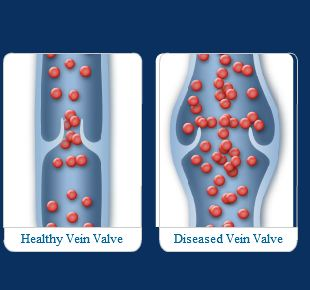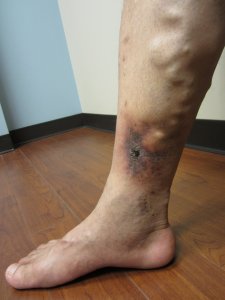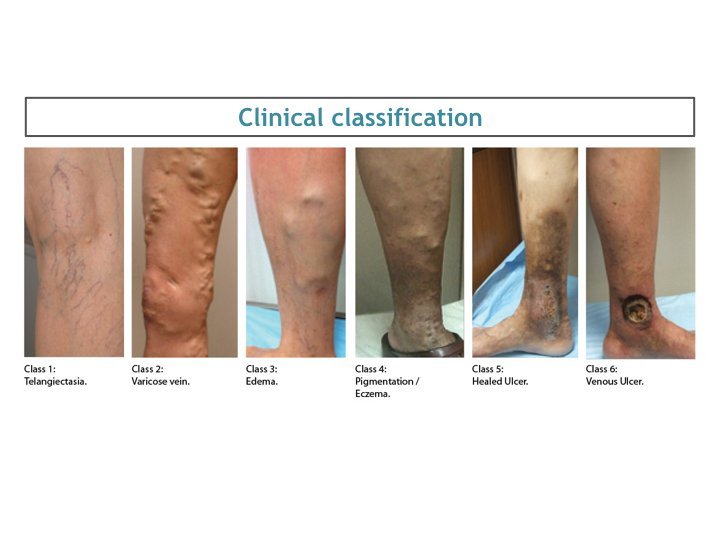Dangers of Varicose Veins
There is a common misconception by the public that varicose veins of the legs are just a cosmetic concern. This is far from the truth. There are many dangers of varicose veins. Varicose veins are a surface manifestation of a deeper circulation disease of the legs. The underlying circulation disease that causes varicose veins to form is called Venous Reflux Disease. Venous reflux disease is also called venous insufficiency. This disease process causes not only visible varicose veins or spider veins to form at the surface level, but also causes deterioration of the tissues of the legs. Also, as the diseased veins form these broken veins are also more prone to development of dangerous conditions such as blood clots (i.e. vein thrombosis), phlebitis, ulcers, and infections. Below we will discuss the most common complication of varicose veins and venous reflux disease and why these dangers exist.
Blood Clot Dangers

Blood clots are one of the most dangerous types of complications that can occur in patients with venous disease. The reason that patients with varicose veins are more prone to develop blood clots is because of the anatomical problem that occurs inside of leg veins as they become varicose. When a vein is healthy and not varicose, it has functional valves that are one way valves that keep blood flowing briskly through the vein tube. The blood is flowing quickly like a stream. But in diseased varicose veins the valves inside the veins become broken and dysfunctional, causing the blood flow to slow down and stagnate like a pond. This slowing of blood flow can lead to blood clots forming in the legs. The valve dysfunction in varicose veins is called venous valve reflux. Blood clots can often enlarge and spread through the venous system and sometime can break free and float to the lungs. People with varicose veins are more prone to blood clots than people with normal veins. This poses a health risk.
When blood clots occur in the legs, pain and swelling can result. Certain situations can increase the risks of blood clots forming in the legs, such as prolonged travel, prolonged immobility, trauma to the legs, and certain medications (including birth control pills). There are ways to help prevent blood clots if you have varicose veins. Consult with a vein specialist to determine your options to help minimize your risk of blood clots.
Phlebitis
Phlebitis or thrombophlebitis is the medical term used to describe sudden acute inflammation that occurs in varicose veins and leads to sudden pain or swelling of the veins of the leg. Phlebitis often will be seen as a tender or red lump in the skin or under the skin. The phlebitis symptoms and skin changes typically occur exactly where the varicose veins are located and sometime immediately adjacent to the veins. It can often spread from one areas of the leg to another. Phlebitis can be dangerous as it is often associated with the development of serious blood clots. If you think that you may have developed phlebitis then you should contact a doctor immediately. An ultrasound of the leg is often indicated to evaluate the condition.
Dangers of Ankles Wounds or Ulcers
Wounds or ulcers that result in patient with varicose veins are often referred to as venous stasis ulcers. They occur as the result of poor circulation causing the tissues and skin to deteriorate. They most often occur in the areas of greatest pressure buildup in the leg, which is around the ankle. There is often brown discoloration of the ankle and foot that occurs prior to the wound or ulcer forming. The ulcers are often painful and can get infected. Venous ulcers and wounds frequently become bigger and recur if the underlying circulation problem and varicose veins are left untreated. If the circulation disease of the veins if properly treated then the ulcers / wounds will usually resolve and heal. See a vein specialist to have circulation testing if you develop ankle ulcers.

Dangers of Bleeding From Varicose Veins
Bleeding from varicose veins is a rather common occurrence. It can occur after a minor bump to the skin, when shaving your legs, or spontaneously due to weakness of the veins and the skin. Varicose veins tend to easily bleed due to the abnormally high pressure build up inside the veins due to the diseased vein valves. Treatment of varicose veins can minimize the risk of vein bleeding. Contact a physician if you develop bleeding from your varicose veins or go the emergency room if the bleeding will not stop. Hold pressures over the area until you can see a healthcare professional.
Skin Dermatitis / Skin Pigmentation
Another common complication that occurs with varicose veins is pigmentation of the skin and skin dermatitis changes. The skin often turns darker, gets firm and dry, the skin often thins, skin inflammation and itching can occur, and redness of flakiness of the skin can occur. These skin changes occur as the result of poor circulation and abnormal pressure build up in the skin. The most common location for these changes to occur is at the ankle and foot (mostly commonly the medial inside area of the ankle). This location is the most common since this is the area where vein pressure builds the most when you are standing and sitting (due to gravity). The dermatitis is progressive and often the areas involved become larger with passage of time. Skin changes can progress to wounds and ulcers if not addressed in a timely fashion. You should see a vein specialist if you experience these symptoms.



